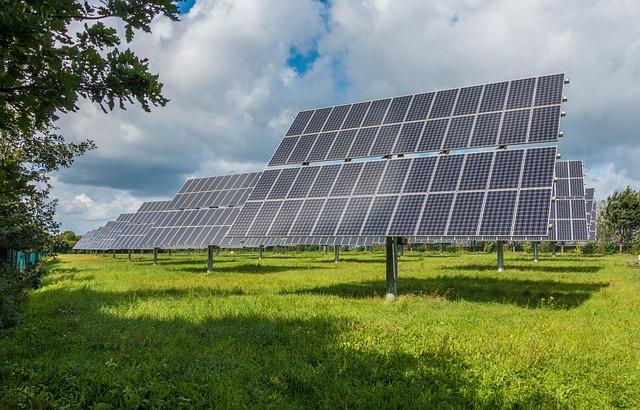- Introduction
- Why Mass Renewable Energy Adoption is Important
- Factors Driving the Shift to Renewable Energy
- Technological Advancements in Renewables
- Challenges and Solutions for Accelerating Expansion
- The Future of Global Renewable Energy Deployment
- Conclusion
- FAQs
Introduction
The world is moving steadily toward mass renewable energy adoption due to a variety of factors, including environmental concerns, economic advantages, and technological advancements. In this article, we will explore why adopting renewable energy on a global scale has become so essential, the driving forces behind this shift, and key innovations that are making this transition possible. Additionally, we'll dive into the challenges that must be addressed to ensure a smooth shift to cleaner power sources, as well as how the future of energy may look with the continued expansion of renewables.
By the end of this article, you should have a clear understanding of the trends shaping the renewable energy space, the barriers to rapid adoption, and the opportunities available for businesses, governments, and consumers.
Why Mass Renewable Energy Adoption is Important

(Image: Pixabay/@Oimheidi)
The accelerated adoption of renewable energy is vital for addressing several critical issues, primarily related to climate change and resource depletion. Fossil fuels such as coal, oil, and natural gas have dominated the energy landscape for decades. However, they produce harmful emissions and contribute significantly to global warming. One of the most prominent reasons for mass renewable energy adoption is to meet international climate targets set out by agreements like the Paris Accord.
Another crucial factor is energy security. By diversifying our energy sources to include wind, solar, hydropower, biomass, and other green technologies, we reduce dependence on foreign oil and non-renewable resources. Countries with abundant renewable resources can become more self-reliant, decrease their vulnerability to supply disruptions, and lower geopolitical risks associated with fossil fuel supplies.
Furthermore, transitioning to renewable energy is linked to economic benefits. Jobs in the green sector are growing at an unprecedented rate—faster than in any other energy sector. From manufacturing solar panels and building wind turbines to installing renewable facilities, countries that adopt clean energy early are poised to become global leaders in technology innovation and job creation.
In addition, renewable energy helps promote public health. Traditional power generation contributes to air and water pollution, which leads to respiratory problems and other health issues. Switching to cleaner energy sources reduces pollutants, enhancing quality of life globally.
Factors Driving the Shift to Renewable Energy

(Image: Pixabay/@EdWhiteImages)
Several key drivers are propelling the global renewable energy shift. These drivers are interconnected, and together they create a strong foundation for accelerating the adoption of clean energy technologies. Among the primary motivators are climate change awareness, government policies, cost reductions, and consumer demand.
First and foremost, greater understanding of the long-term consequences of climate change has put enormous pressure on businesses and governments alike to reduce their carbon footprints. The need to combat rising temperatures and the detrimental effects of climate change is perhaps the single largest driver of renewable energy adoption. Policymakers have passed stringent laws and set ambitious emissions-reduction targets to mitigate these climate crises.
The economics of renewables have changed drastically due to significant technological improvements. Over the past decade, the costs associated with solar and wind energy have plummeted. Solar photovoltaic costs, for example, have decreased by more than 80%, making these options financially viable without subsidies. As costs continue to decline, renewable energy becomes an increasingly attractive alternative to fossil fuels.
Growing consumer demand for greener energy is also pushing utilities and companies to adopt renewables. With heightened awareness and education, individuals are seeking cleaner energy options, often opting for providers or services that prioritize sustainability. Millennials and Gen Z consumers, in particular, are championing environmentally responsible choices that are shaping corporate strategies and investments into renewable energy infrastructure.
Additionally, advancements in energy storage and grid technologies, such as battery storage solutions, are enabling intermittent renewable sources like solar and wind to be more consistent and reliable. This ensures a steady and continuous supply of energy, closing one of the gaps that previously hindered widespread renewable adoption.
Technological Advancements in Renewables

(Image: Pixabay/@Myriams-Fotos)
The trajectory of renewable energy adoption is heavily influenced by ongoing innovations and technological developments. These breakthroughs help to overcome previous limitations by improving both efficiency and effectiveness of renewable energy systems. Let’s look at several key advancements shaping the future of clean energy.
One of the most exciting areas is the improvement of solar photovoltaic (PV) technology. Modern innovations in silicon-based PV cells, alongside thinner, more flexible materials, are drastically improving energy capture efficiency and reducing manufacturing costs. Companies around the world are experimenting with "perovskite" solar cells, which show potential to be even cheaper and more efficient than traditional cells. Further research and development are unlocking additional efficiency gains and lowering energy conversion losses.
Wind turbine technology has also seen substantial advancements. New turbine designs that incorporate larger blades and higher towers allow for greater energy harnessing, especially in offshore environments where strong winds provide consistent power generation. Turbines are being designed to work in varied terrains and weather conditions, expanding their deployment areas across the globe.
Smart grid technologies represent another remarkable advancement aiding renewables. These grids use digital communication and automation to manage power flows more effectively. With intelligent sensors and algorithms, smart grids can integrate variable energy sources like wind and solar with existing infrastructure better, ensuring reliable energy delivery around the clock.
Energy storage solutions, particularly battery technology, are revolutionizing how we store excess energy during peak production times. Lithium-ion batteries and emerging alternatives like solid-state batteries are dramatically increasing capacity, longevity, and stability. Energy storage development will play an essential role in achieving a future where renewable energy can completely replace conventional power sources.
Challenges and Solutions for Accelerating Expansion

(Image: Pixabay/@Myriams-Fotos)
The adoption of renewable energy while promising does not come without its own set of challenges. These hurdles must be understood and addressed if widespread implementation goals are to be realized. Fortunately, many solutions are already being explored to overcome these barriers.
One of the most frequently cited challenges is the intermittency of renewable energy production, particularly with solar and wind. Since these energy sources depend on environmental conditions, there are times when generation doesn’t meet demand, such as cloudy or windless days. However, continuous improvements in battery storage systems, as well as hybrid energy grids balancing renewables with backup sources like biomass, are helping to counteract these fluctuations.
Cost barriers, particularly upfront capital requirements, are another challenge slowing renewable energy growth, particularly in developing regions. While the cost of renewable energy has dropped significantly, some communities still lack the financial infrastructure to deploy large-scale installations. Efforts to devise innovative financing models, such as performance-based incentives and public-private partnerships, could provide key solutions for underfunded projects.
Regulatory roadblocks can also impede renewable energy expansion, especially given that regulations and permitting processes differ widely between countries. A harmonized policy framework and legal certainty are required to enable investments and streamline development of green energy projects. Governments must work hand-in-hand with the private sector to adjust laws and regulations to facilitate growth.
A final challenge involves public perception and misinformation. Some communities remain skeptical about renewable energy reliability and economic viability. This can stall progress, particularly if local opposition leads to delays in project approvals. Educational campaigns highlighting the long-term benefits, community engagement initiatives, and transparent partnerships can help shape a more favorable narrative around renewable energy.
The Future of Global Renewable Energy Deployment

(Image: Pixabay/@mrganso)
The future of renewable energy is bright, with numerous trends suggesting increased adoption worldwide. As governments, corporations, and consumers prioritize sustainability, renewable energy will play a dominant role in reshaping the global power landscape. Technological innovations, combined with evolving policies, stand to make renewables more accessible and affordable for all regions—both industrial and emerging economies.
One interesting future trend is the continued decentralization of energy production. Technologies like home batteries, microgrids, and distributed solar power enable households, businesses, and communities to generate and store their own energy, removing dependency on centralized power plants. This shift allows greater resilience and flexibility in energy management.
Artificial intelligence (AI) and data analytics will likely take center stage in optimizing global renewable energy networks. Machine learning algorithms can predict energy consumption patterns, weather variability, and grid stability. This will ultimately enhance the coordination of renewable energy resources and grid operations, thus boosting efficiency.
Beyond electricity generation, renewable energy-powered transportation will be at the forefront of reducing emissions. Electric vehicles (EVs) are becoming more accessible, and as renewable energy prices drop, EV charging stations powered by solar or wind farms will become commonplace. This dual focus on clean electricity and zero-emission transport presents a comprehensive road map toward decarbonization.
Renewable hydrogen—a supplemental energy source—is anticipated to emerge as a key player for sectors like heavy industry and aviation, which are harder to electrify. Hydrogen produced from renewables can serve as a clean fuel replacement, further reinforcing the complete transition to a green, sustainable economy.
Conclusion
Mass renewable energy adoption has immense potential to transform how we power our homes, industries, and transportation systems while addressing pressing environmental, social, and economic challenges. The global shift toward renewable energy continues to gather momentum as costs fall, technology improves, and growing public awareness drives demand.
However, achieving the scale needed to mitigate climate change and build resilient energy systems requires continued effort, collaboration, and innovation. By leveraging the technological advancements we have made and addressing the remaining challenges, the vision of a fully renewable-powered future appears within reach.
FAQs
What are the main types of renewable energy?
Solar, wind, hydropower, geothermal, and biomass are the most common types of renewable energy. Each has its unique benefits and applications depending on geographical availability and technological capability.
Is renewable energy cheaper than fossil fuels?
Yes, in many cases, renewable energy has become either cost-competitive or even cheaper than traditional energy sources such as coal and natural gas, especially with advancements in technology and economies of scale.
How does energy storage contribute to renewable energy adoption?
Energy storage systems, such as lithium-ion batteries, allow excess energy generated by wind and solar power to be stored and used when demand exceeds supply, helping to balance grids and enhance overall system stability.
Can developing countries benefit from renewable energy?
Absolutely. Renewable energy offers developing nations an opportunity to leapfrog traditional fossil-fuel infrastructure, providing reliable and sustainable power solutions that promote economic growth and development.
What is the biggest barrier to renewable energy adoption?
The intermittency of renewable energy along with regulatory and upfront cost barriers are among the largest challenges facing widespread renewable adoption. However, emerging technologies and innovative financing solutions are helping to resolve these issues.

